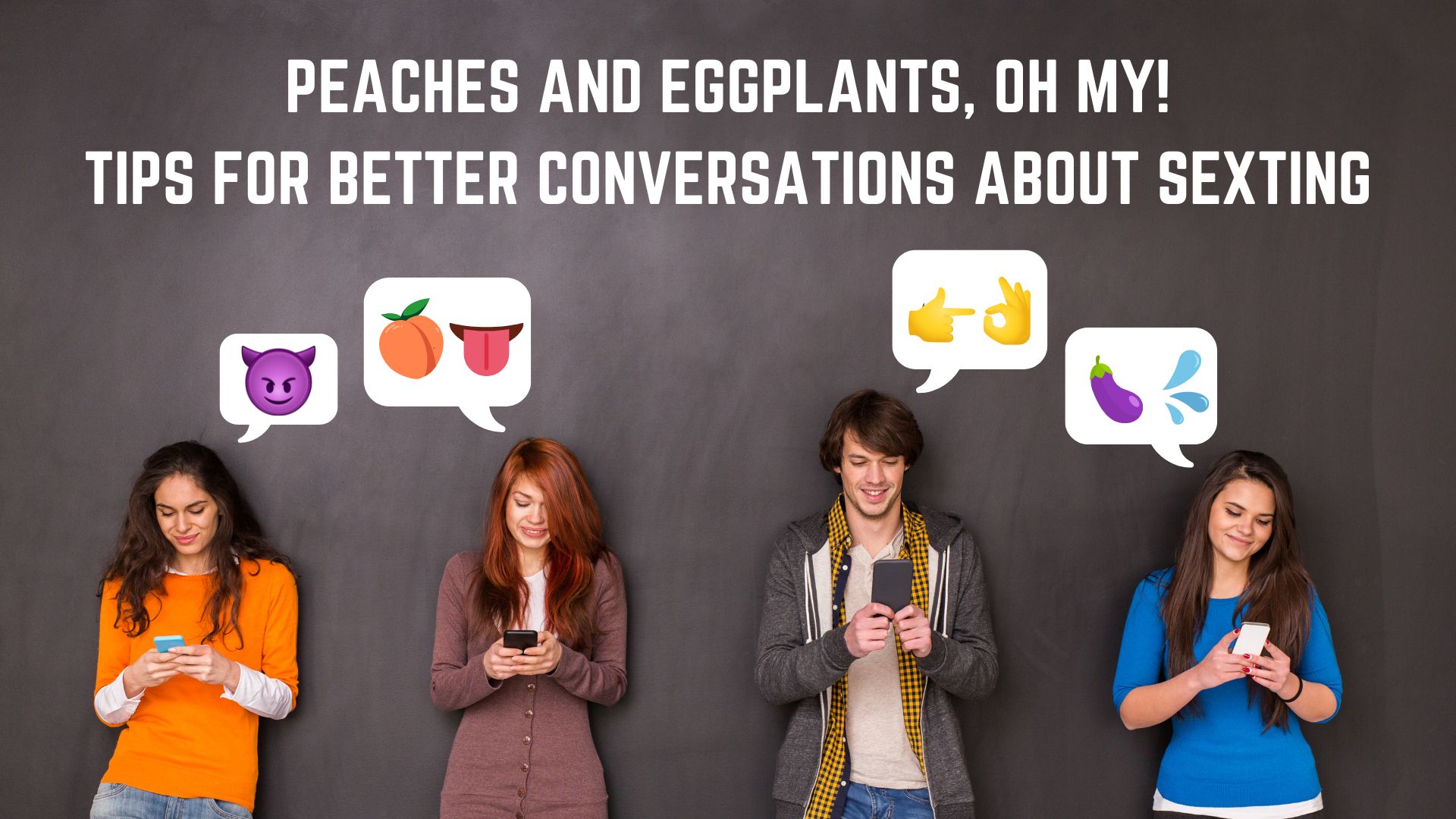Written by Jessica, RSEI Educator | Published September 16th, 2024
Before peach and eggplant emojis were ever exchanged in Instagram DMs, there were erotic love letters, privately commissioned nude paintings, and a little while later, sexy polaroid pictures. For centuries, people have been making their sexual selves known using different types of media. People today are most commonly familiar with this kind of sexual expression through the form of sexting.
Sexting can mean different things to different people: a sexy phone call, texts, or instant messages that involve roleplay or talking about sexual fantasies, exchanging suggestive emojis, nude pictures (aka “nudes”), videos, or even voice messages.
Some young people may choose to sext, while others may not – and this is true regardless of whether they are having physical sex. It’s a valid form of sexual expression, and curiosity about or engaging in sexting in the digital age is a common part of sexual development. According to one 2021 meta-analysis published in the Journal of Adolescent Health, it’s estimated that 19.3% of teens have sent a sext while 34.8% have received one.
Considering the harsh legal consequences associated with underage sexting in the U.S. – as well as harm that can happen when sexts are shared without consent – it can be tempting to send the message of “just don’t do it” to the young people in our lives. But experts who study sexting believe that shutting down conversations around the intersections between sexuality and digital media may do more harm than good.
Recognizing that sexting can and will happen, acknowledging why people sext and what the outcomes may be, and being prepared to talk openly about it can go a long way in helping teens navigating sexting in a way that feels empowering and safe for them.
Why do people sext?
Reasons to sext are as many as the people who choose to do it. Before entering a classroom or other setting to discuss sexting with young people, it can be helpful to brainstorm some of the many reasons people of all ages might sext. Here are a few reasons, can you think of any others?
- Sexting can be a form of sexual expression for people who are abstinent from physical sex
- It’s a sexual behavior that doesn’t pass sexually transmitted infections or cause pregnancy
- For people who face barriers to physical sex due to factors like disability or location, sexting can be an accessible way to engage sexually with partners
- Can provide a non-physical space, which may feel safer to some, to explore different desires
- Can help long-distance partners feel connected
Why is there fear around sexting?
People of all ages choose to sext. But even consensual sexting between minors is highly criminalized in many states across the U.S., and individual schools may also punish young people for sexting even if what took place wasn’t illegal.
Researchers who study sexting, like Colorado University professor Amy Adele Hasinoff, have reason to believe this kind of criminalization may be enforced unfairly based off biases around class, race and sexuality from families.
It’s worth unpacking why sexting between consenting teenagers is so vilified in the U.S. Why do many states have laws allowing teens to consent to physical sex – which comes with its own challenges to consider– but not with young people willingly taking and sharing photos of themselves?
There are some efforts across the U.S. to decriminalize consensual sexting among young people. This includes the state of , which decriminalized consensual sexting for teens between the ages of 14-18 back in 2016 and, later the state of .
Other fears surrounding sexting may have to do with violations of consent and privacy. Since text messaging and camera phones have become a larger part of society, issues like sextortion and more recently deepfake nudes have left many people feeling violated. These concerns are very real, and a large part of why open and honest conversations around sexting and other digital interactions are so crucial.
How can we have better sexting conversations?
The good news is that sexting can be a starting point to explore how sexual health topics like communication and consent operate in real life.
When it comes to sexting, we can encourage young people to reflect on different questions that promote open communication and consent in their relationships. Here are some examples of questions that could be discussed with young people:
- What does sexting mean to you? Is it photos, videos, emojis, text messages, or something else?
- What does sexting mean to any partners you sext with? How will you communicate with them about sexting?
- How do you know you trust someone you are considering sexting? Do you have a plan in place for what happens after one or both of you choose to stop sexting?
- What agreements might you want to make with a person you sext, such as agreeing to delete sexts after a certain time or agreeing to not share sexts with others?
- If you don’t want to sext, but someone asks you to, how will you communicate no?
- Who is a trusted adult or person I can talk to if I have questions or concerns about sexting?
It’s also important that young people are aware of how the sexting laws in their states and policies at their schools could affect them. But it’s not only about whether someone might get in trouble for sexting or even sharing photos without permission — talking about sexting is also great opportunity focus on empathy and respecting others. How might it feel for a person to have their photo or information shared without permission?
There are also practical steps that young people can take when sexting to help them stay safe and feel empowered. Here are a few examples:
- Make sure to know personally or verify the identity of the person you sext with
- Only sext with people who have consented or agreed to sext with you
- Consider text message sexting, rather than exchanging photos which could be shared without permission or could result in criminalization
- Consider boudoir-style photos, rather than nudes
- Excluding your face or other identifying information in nude photos can reduce the chances of being identified if photos are shared without permission
- If someone sends you something, it’s not okay to share it with anybody else
- Keep a lock on your phone to help keep any photos or texts private
- Talk to a trusted adult if someone is sending you nude photos without your permission, sharing your photos without permission, or pressuring you to sext when you don’t want to
It is time to get real about sexting. Recognizing that young people may sext and acknowledging some of the positives and challenges that come with it can go a long way. Consider sexting conversations as an opportunity to talk about key sexual health topics, like consent and communication, to help young people feel safe and empowered.





